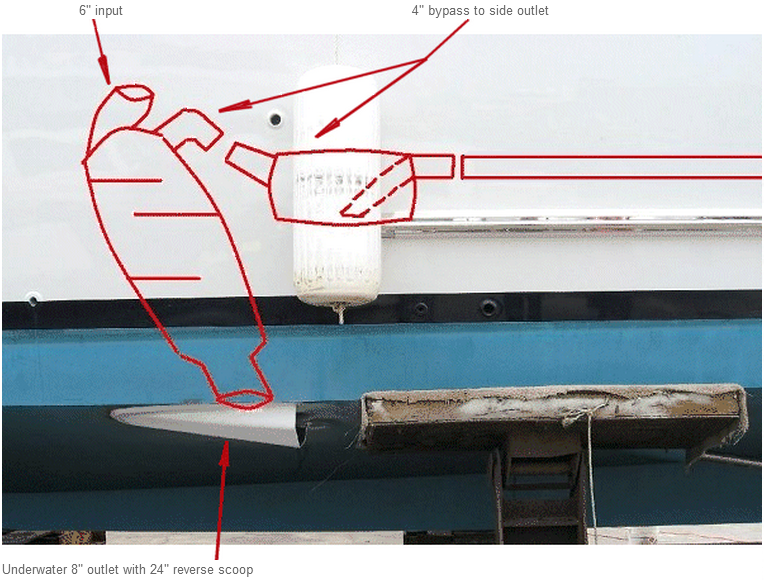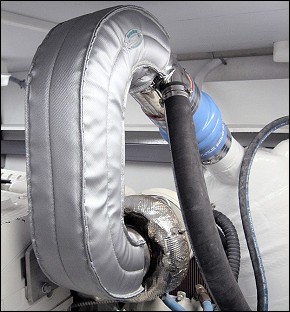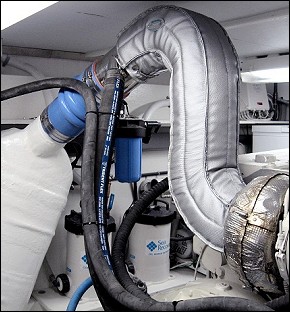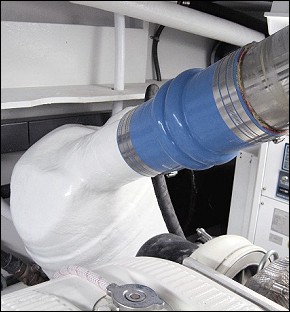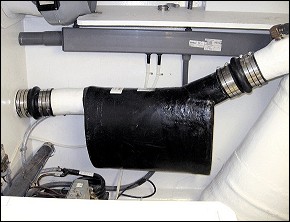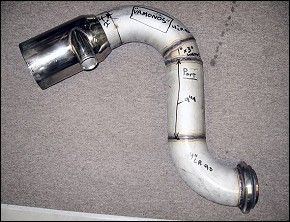Some Thoughts on Underwater Exhaust Systems
Underwater exhaust systems can offer many advantages (and some disadvantages) to the overall design on a boat. In some cases, going “underwater” may be the only choice in many applications because exhaust routing from the engine room to the stern is close to impossible, or good planning was not done during the initial design. Having underwater exhaust may seem like the ultimate way to go, simple, “it must be super quite”, and “maybe I don’t even need a muffler”. Well, this is not the necessarily the case at all as going underwater adds another dimension to the exhaust system many builders soon find out at first seatrials. “RUMBLE”
Typically, underwater exhaust is what is normally referred to as “exhaust exiting” through the bottom of the boat, but in some cases, underwater exhaust could also be exhaust exiting at the transom or the side of the boat that is below the waterline. Since exhaust exiting at the transom (or on the side of the boat below the waterline) may or may not be “under water” when the boat is traveling forward I am confining this page to exhaust exiting thru the bottom of the boat, which is always under water.
As many boat owners may have already figured out from personal experience, underwater exhaust may not be the perfect solution to noise control, although many with no experience in underwater exhaust always seem to think, “What could be a simpler way of muffling an engine’s exhaust system.” It seems that most underwater exhaust systems that I have seen in the last ten years have had issues with rumbling at low to medium speeds, causing a different type of “discomfort” in the confines of the vessel. Although the outside noise may be low, the exhaust energy that is dispersed beneath the vessel’s hull can have a tendency to create a low frequency and very uncomfortable “rumble” or vibration inside the vessel at some speeds.
What we have learned about underwater exhaust in the past 20 years is that mufflers still need to be an integral part of the exhaust system so that the exhaust energy is reduced / absorbed before exiting the vessel.
Some advantages of underwater exhaust are that it allows the exhaust to exit in the engine room floor and not have to travel at its full size dimensions all the way to the transom. Over the years we have found many boats have no provisions for increasing the size of the exhaust piping aft of the engine room or is close to impossible to do, leaving us no choice but to exit the side of the vessel, OR, underwater. Sometimes we even use a combination of underwater and a stern exit / bypass. The exhaust system on any vessel needs to be carefully examined to see if an underwater solution is feasible, and / or is, the best alternative.
One of the main goals with any underwater exhaust system that can be used to the advantage of the vessel owner is the forward movement of the boat, in that it can and will create a low pressure area with the forward movement of the vessel keeping back pressure to a minimum when designed correctly. In many cases, this is a distinct advantage and allows a smaller size to be used which would go against most ideas as to how exhaust systems actually work.
Below are some pictures and a simple “outlet drawing” drawing showing the basic layout of a typical underwater exhaust system with a horizontal inline muffler that has been modified to operate vertically, and a smaller bypass muffler. Again, this is only a typical representation, as many times, a lift muffler is used as the main muffler before the underwater exit, as it can be the best choice for some applications.
Cummins QSM 670 UNDERWATER exhaust system
The system uses a 4″ dry riser w/ 6″ mixer, to a highly modified muffler, and under water outlet. Notice the 4″ wet bypass to the transom that incorporates a small inline lift muffler – This particular system showed under 20″ H2O exhaust pressure at WOT and was very quiet at all speeds.
Basic layout for this particular vessels exhaust system. When the builder designed this vessel, he left zero provisions for a conventional stern exhaust, so an “underwater” solution had to be found.
And last is the most obvious criteria for any underwater exhaust design – With any underwater exhaust system, the exit thru the bottom of the vessel needs to be designed in such a way the it is no more vulnerable to cause an issue with as to hull damage, physical penetration, water intrusion, failure of components , or ? as the main hull itself. So leave this part of your vessel design or repower to a company or builder well versed in this type of work and has a proven long term record in building underwater exhaust systems.

